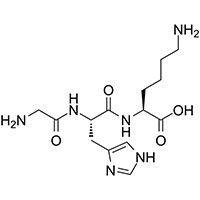Glycyl-L-Histidyl-L-Lysine
Nanjing Finechem Holdings Co., LTD
Synonyms
Liver growth factor
Gly-L-His-L-Lys
Liver cell growth factor
L-Lysine, glycyl-L-histidyl-
Glycyl-L-Histidyl-L-Lysine
GHK Cu Copper Peptide
H-Gly-His-Lys-OH
glycyl-histidyl-lysine
ghk
Copper Peptide
Ahk-cu
Growth-modulating peptide
Gly-His-Lys-Cu
Copper Peptide (GHK-Cu)
Product Description
Introduction:
Glycyl-L-Histidyl-L-Lysine is a significant chemical compound with diverse applications in the chemical
industry. This product introduction aims to provide an overview of Glycyl-L-Histidyl-L-Lysine, covering
its raw materials, production process, market trends, and the current status of amino acids in the
industry.
Raw Materials:
Glycyl-L-Histidyl-L-Lysine is synthesized using glycine, L-histidine, and L-lysine as the primary raw
materials. Glycine, L-histidine, and L-lysine serve as the precursors for the synthesis of
Glycyl-L-Histidyl-L-Lysine.
Production Process:
The production process of Glycyl-L-Histidyl-L-Lysine involves the following steps:
Step 1: Coupling - Glycine, L-histidine, and L-lysine are coupled using suitable coupling agents or
reagents to form Glycyl-L-Histidyl-L-Lysine. The coupling reaction is typically carried out in an
appropriate solvent under controlled conditions.
Step 2: Purification - The resulting Glycyl-L-Histidyl-L-Lysine is purified and refined using techniques
such as filtration, chromatography, or crystallization to achieve the desired level of purity.
Market Trends:
The market demand for Glycyl-L-Histidyl-L-Lysine has been increasing due to its diverse applications
across various industries. Here are some key market trends:
Pharmaceuticals: Glycyl-L-Histidyl-L-Lysine finds applications in the pharmaceutical industry. It can be
used as a peptide-based drug or as a component in drug formulations targeting specific therapeutic
areas. Peptide-based drugs have gained significant attention due to their high specificity and targeted
activity.
Cosmetics: Glycyl-L-Histidyl-L-Lysine is also used in the cosmetic industry. It can be incorporated into
skincare products for its potential anti-aging and skin-conditioning properties. Peptides are known for
their ability to promote collagen synthesis and improve skin elasticity.
Current Status of Amino Acids:
Amino acids play a crucial role in various sectors, including pharmaceuticals, cosmetics, and
biotechnology. They are the building blocks of proteins and have diverse functions in living organisms.
Glycine, L-histidine, and L-lysine are among the important amino acids used in various
industries.
Conclusion:
Glycyl-L-Histidyl-L-Lysine, synthesized by coupling glycine, L-histidine, and L-lysine, holds
significant value in the chemical industry. Its production involves the coupling of the amino acids,
followed by purification. The market demand for Glycyl-L-Histidyl-L-Lysine is driven by its applications
in the pharmaceutical and cosmetic industries. Amino acids continue to be essential components in
various industries, contributing to advancements in chemical applications and product
development.





